Discovering Dubai's Best Mandi Restaurants
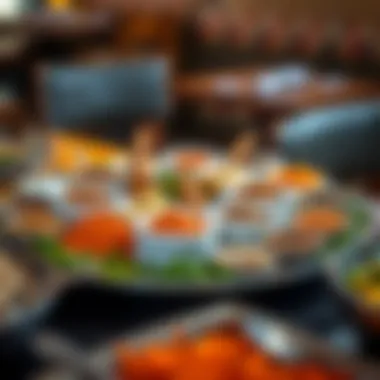
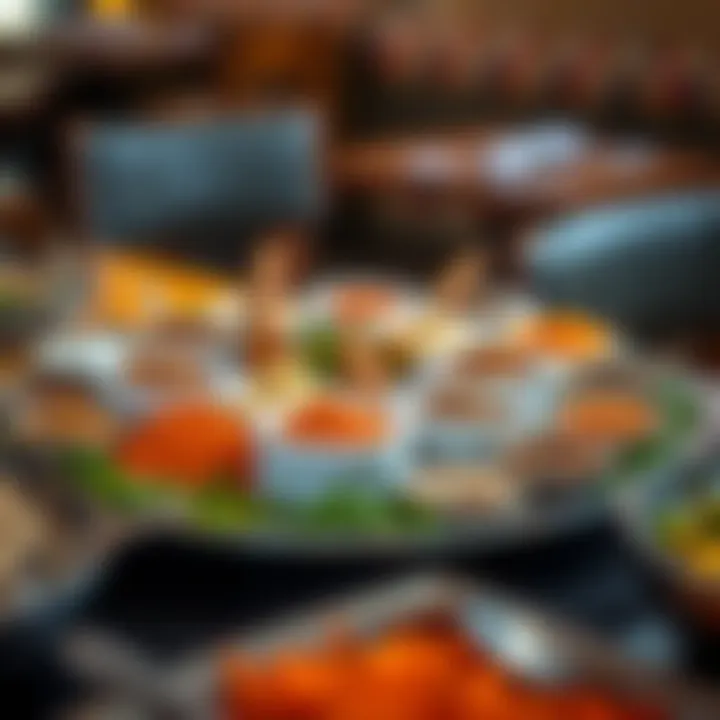
Intro
Mandi, with its aromatic spices and tender meat, encapsulates the rich culinary traditions of the Arabian Peninsula. Originating from Yemen, this cherished dish has found a second home in Dubai, where it blends with the city’s multicultural essence. The city's love for Mandi reflects not just a palate preference but also a cultural acceptance and celebration that transcends borders. From lavish weddings to humble family gatherings, Mandi graces the tables of many Dubai residents.
Dubai’s key role as a culinary melting pot cannot be overstated. The dish showcases various preparation techniques that are as diverse as the city’s populace. Restaurants serving Mandi vary in style and atmosphere, offering everything from luxury dining experiences to casual neighborhood eateries. Each establishment imparts its unique flair on the age-old recipe, creating a kaleidoscope of flavors waiting to be explored.
This article presents a comprehensive exploration of Dubai’s best Mandi restaurants. Expect to dive deep into the cultural roots of Mandi, its historical significance, and its evolving presence in the culinary scene today. We’re not just discussing where to eat; we’re also uncovering how this dish reflects the city's vibrant tapestry and diving into how you can best enjoy authentic Mandi.
Key Points Covered
- Cultural significance and history of Mandi in Dubai
- Overview of various dining establishments serving Mandi
- Location-specific highlights addressing accessibility
- Pricing range to fit all budgets
- Personal dining experiences and recommendations
Prepare to savor the journey through flavors and culture as we unravel the best places to relish Mandi in this dynamic city.
Prolusion to Mandi Cuisine
Mandi is more than just a dish; it is a cultural centerpiece that encapsulates history, tradition, and a unique culinary art form. Its importance in this article lies in how it provides a comprehensive understanding of not only the flavors but also the deeper connections within the community that enjoy this delicacy. Exploring Mandi's various aspects deepens appreciation and transforms a simple meal into a shared experience that resonates at multiple levels.
Historical Context
To fully grasp the essence of Mandi, one must first delve into its historical roots. Mandi originated in the Arabian Peninsula, particularly in Yemen, where it was traditionally prepared for festive occasions. The cooking method, which involves slowly roasting meat and then mixing it with spiced rice, showcases a harmonious blend of flavors that is emblematic of Middle Eastern culinary practices. Over the decades, as trade routes expanded and cultural exchanges flourished, Mandi made its way to different regions, adapting along the way.
In Dubai, for instance, the dish saw morphological changes, not just in flavor but also in presentation. Previously only savored during special gatherings, Mandi emerged as a popular staple, accessible to the everyday person. Its evolution reflects the amalgamation of various cultural influences that have interacted with Emirati traditions. At each juncture in history, Mandi has retained its core identity while embracing new elements, marking it as a culinary evolution worth pondering.
Cultural Significance
Mandi serves as a social glue, uniting families and friends as they gather around the table to share this flavorful dish. It is often seen as a symbol of hospitality, where serving Mandi to guests conveys respect and warmth. The act of sharing a large platter, typically eaten with hands, fosters a sense of camaraderie and connection that modern dining customs often overlook.
In Dubai, Mandi also holds cultural significance within expatriate communities. As diverse populations bring their culinary heritage, Mandi becomes a canvas where different spice blends and cooking techniques collide. This blend creates an ongoing dialogue among cultures, demonstrating how food can transcend boundaries, sparking conversations of identity and community.
"Food is not just sustenance; it's a reflection of culture and shared experiences. Mandi stands testament to this idea, weaving together history and community."
Whether it’s an elaborate wedding feast or a casual get-together among friends, Mandi shapes social interactions and fosters relationships, reminding us of the importance of shared culinary experiences in our increasingly fragmented world.
The Essence of Mandi
Mandi is not just food; it's a rich tapestry woven from centuries of history, culture, and tradition. This dish, originally from the Arabian Peninsula, serves more than just as a meal; it unites families and friends around the dining table, embodying hospitality and shared heritage. Understanding the essence of Mandi delves into the ingredients that bring life to this dish and the age-old techniques that chefs have perfected over generations.
Ingredients and Preparation Techniques
The magic of Mandi lies in its quality ingredients and meticulous preparation methods. At its core, Mandi consists of fragrant basmati rice, tender meat—often chicken or lamb—and a carefully orchestrated blend of spices. Common spices include saffron, cardamom, and cloves, adding depth to the flavor profile.
The preparation method is critical. It begins with marinating the meat, often overnight, using a mix of spices and sometimes yogurt, which tenderizes the meat while infusing it with flavor. Next comes the slow cooking technique, where the meat is typically simmered in a special pot called a 'madra,' allowing the flavors to meld and develop. The final stage involves layering the rice atop the meat, allowing it to steam and absorb the fragrant aromas. This method arms the dish with a particular kind of richness that makes it irresistible.
Moreover, certain establishments take pride in using traditional tandoors or clay ovens, imparting a smoky flavor to the meat that enhances the overall taste. The labor of love doesn't end here; garnishing with fried onions, nuts, and herbs elevates the dish, showcasing both visual appeal and diverse textures.
Varieties of Mandi
Mandi's versatility shines through its various regional adaptations. It can be found in multiple styles across the Gulf region, each bringing its unique twist to the table. For instance, Mandi Al Dajaj is a chicken-based version featuring bright, zesty flavors, while Mandi Al Lahm revolves around succulent lamb, often revered for its rich taste.
- Vegetarian Mandi: For those inclined towards plant-based dishes, vegetable Mandi uses mixed vegetables and spices to create a delicious alternative.
- Seafood Mandi: A special variant that includes fish or shrimp, this version highlights the maritime influence found in coastal regions.
- Spicy Mandi: Some diners seek an extra kick, thus opting for spicy Mandi, which amplifies the chili flavor, catering to those who enjoy heat in their meals.
Ultimately, what sets Mandi apart isn't just how it’s made, but the context in which it is enjoyed. Mandi often represents festive occasions and gatherings, symbolizing warmth and a sense of community.
"Mandi has become a culinary bridge, connecting diverse cultures through its flavors and meal-sharing traditions."

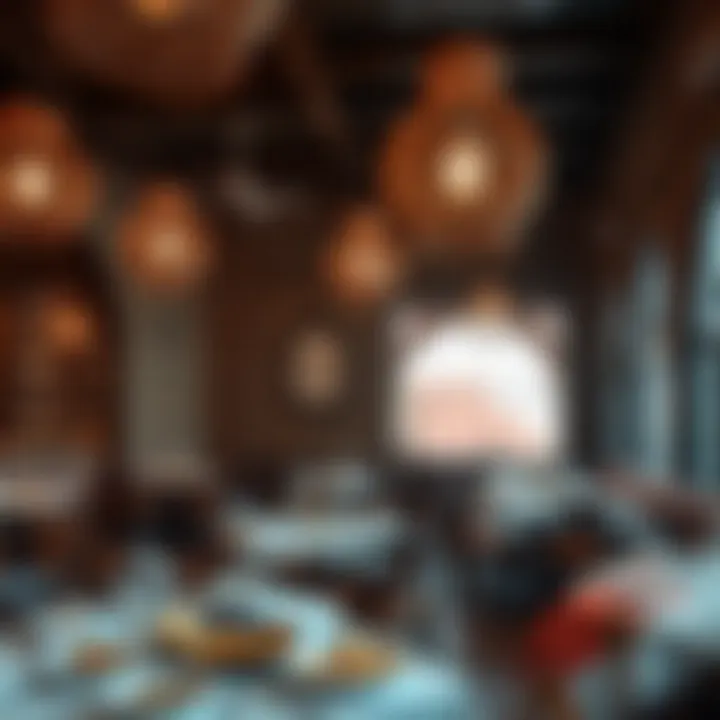
Mandi's Popularity in Dubai
Mandi, a flavorful rice and meat dish, has carved a niche for itself in Dubai's vibrant culinary scene. Its ascendance as a favored dining option can be attributed to various factors, with the most significant being the city's diverse demographics. The blending of cultures makes Dubai a melting pot, where traditional foods from various regions meet modern tastes. Mandi, with its roots in Arabic cuisine, resonates strongly with both locals and expatriates, leading to a growing appreciation for this historical dish.
Notably, Mandi offers a tapestry of aromas and spices that captivate diners. The intricate preparation methods, which involve slow-cooking the meat alongside rice that soaks up all the savory flavors, tickle the taste buds of those who seek both comfort and authenticity in their meals. Its popularity in Dubai is not just about how it tastes but also how it brings people together, symbolizing hospitality and communal dining — a central aspect of many Middle Eastern cultures.
Influence of Expatriate Communities
The demographic landscape of Dubai is remarkably diverse, with a large expatriate presence that has significantly influenced Mandi’s popularity. With communities from the Indian subcontinent, Southeast Asia, and the Middle East, these expatriates have brought their culinary preferences along, making Mandi a dish that appeals to various palates. As these groups set up restaurants and eateries, they often introduce their own twists to the traditional Mandi recipe, which results in exciting variations.
For instance, Indian and Pakistani chefs may integrate spices common in subcontinental cuisines, adding a touch of heat and depth that enhances the original flavor. Furthermore, social gatherings often center around shared meals, and Mandi, served in large platters, provides an ideal dining experience that promotes sharing. This communal aspect resonates with the customs of many cultures represented in Dubai, thereby driving its popularity further.
Culinary Trends
The culinary scene in Dubai is ever-evolving, and Mandi is right in the thick of it. Recent trends illustrate a shift toward healthier and more sustainable eating practices. As a result, many Mandi restaurants are now offering organic meat and locally sourced ingredients, which not only enhance the dish's taste but also align with health-conscious consumer preferences.
Moreover, with the increasing tourism in the region, Mandi restaurants are stepping up their game by incorporating international culinary standards into their offerings. Some establishments have begun hosting Mandi tasting events, pairing the meal with various beverages, including traditional Arabic coffee or even modern twists like craft sodas. This not only elevates the Mandi experience but also positions these restaurants as innovative dining spots.
"Mandi is not just food; it's a cultural experience that showcases the rich heritage of the Middle East. Its adaptability to contemporary tastes only adds to its allure in a modern city like Dubai."
Top Mandi Restaurants in Dubai
The importance of highlighting the top Mandi restaurants in Dubai lies not just in the dishes they serve but also in the stories they tell. These establishments are the heart and soul of the Mandi experience in the city. Each restaurant showcases its unique take on this traditional dish, blending history with modern culinary trends, making it essential for anyone keen on understanding Mandi cuisine to explore these key players.
Beyond simply tasting the food, visiting these restaurants offers insights into the cultural tapestry that forms Dubai. With an array of flavors and a hub where families and friends gather, these restaurants foster community spirit and culinary tradition. They afford patrons a glimpse into the culinary evolution of Mandi, which was originally a staple of Bedouin cooking before it embarked on this delightful journey into the heart of the city.
Al Ibrahimi Mandi House
Al Ibrahimi Mandi House stands out as a prominent spot for anyone craving authentic Mandi in Dubai. This restaurant swiftly gained a reputation for its flavors that reflect the traditional essence of Mandi cooking. With a decor that echoes the rich heritage of Arabian culture, diners feel as if they have stepped into a welcoming oasis. The dish served here is nothing short of spectacular, featuring perfectly cooked meat, aromatic rice, and spices that dance on your palate.
Visitors can expect nothing less than outstanding service, where the staff is knowledgeable about the menu and eager to offer recommendations based on personal tastes. There’s a certain charm in the hustle and bustle of the restaurant during peak hours, where the warm atmosphere enhances the overall dining experience.
Mandi House
Mandi House is another must-visit for enthusiasts of this traditional dish. Known for its focus on quality, this restaurant prides itself on using only the freshest ingredients, ensuring that each plate is bursting with flavor. The ambiance is friendly and inviting, making it a great place to gather with family or friends.
One notable aspect of Mandi House is its dedication to preserving the authenticity of Mandi. Patrons can savor a range of preparations, from lamb to chicken, all slow-cooked to perfection, infusing the rice with rich flavors and aromas that are hard to forget. Highly regarded by both locals and tourists alike, Mandi House has carved out a niche that continually attracts diners wanting a taste of what real Mandi is like.
Shaharazad Restaurant
Stepping into Shaharazad Restaurant is like taking a culinary journey through the Middle East. The vibrant colors and decor, inspired by local art, set the stage for a lavish meal. Shaharazad focuses heavily on presentation as well as flavor, making each dish not just a meal but an experience.
The restaurant offers an impressive range of Mandi options, allowing guests to explore flavors that span the entire region. The attention to detail is evident, from the first bite to the meticulous garnishing. Each dish is served with a side of warmth and hospitality synonymous with Arabic culture. The combination of scintillating rice and tender meat crafted to perfection makes it a crowd favorite.
Bait Al Mandi
Bait Al Mandi is known for its homey feel and authentic atmosphere. It represents a fine balance between traditional cooking methods and a friendly environment where diners can relax and enjoy their meals. The menu here resonates with those who appreciate Mandi made with dedication and tradition.
What makes Bait Al Mandi special is its vast selection. From spice blends to cooking techniques, they offer an array of choices that respect the history of Mandi while allowing for personal preferences. Regular patrons often return not just for the food but for the sense of belonging that Bait Al Mandi provides.
Khadra Restaurant
Khadra Restaurant has made a name for itself by offering an extensive variety of Mandi, blending different influences into a single meal. The ambiance is striking, with decorative elements that hint at rich Arabic culture. Diners will find themselves enjoying a relaxed meal with friends or family while savoring some incredible flavors.
The restaurant’s commitment to quality is evident in the ingredients they use. Locals frequently praise the tenderness of the meat, which is slow-cooked to achieve that melt-in-your-mouth texture. Each visit to Khadra is a chance to experience a culinary delight that showcases the true essence of Mandi.
Mandi Dining Experience
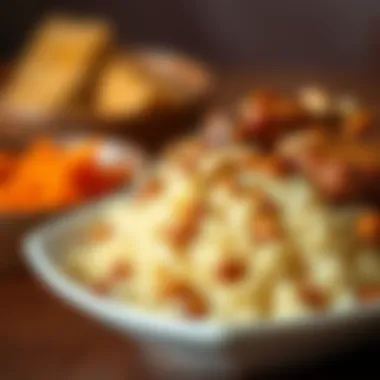
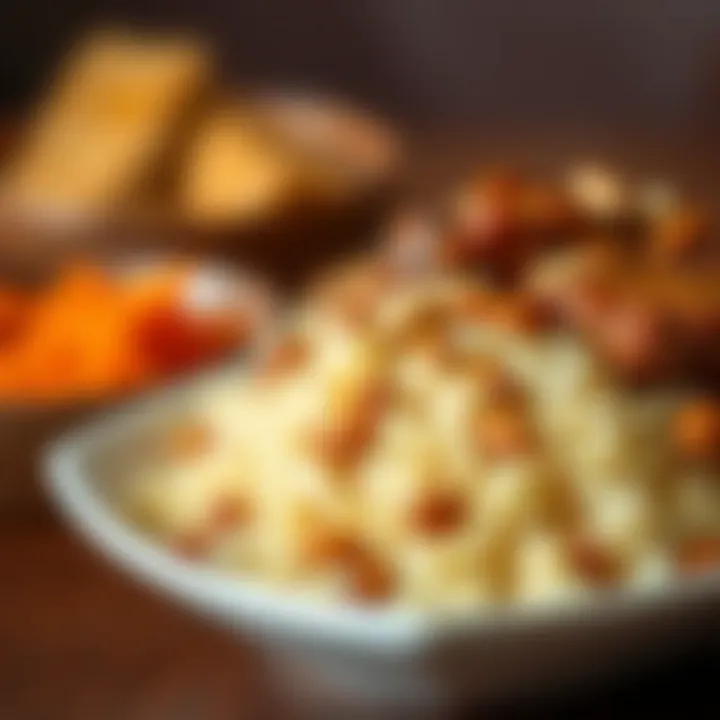
The Mandi dining experience isn’t just about the food itself; it encapsulates a blend of tradition, culture, and sensory delight. In Dubai, where culinary diversity reigns supreme, the act of enjoying Mandi becomes a ritual that goes beyond mere consumption. It’s an experience steeped in history and hospitality, providing diners with a glimpse into the rich tapestry of Arab culture. Here, we’ll delve into the ambiance, decor and the quality of service that mark the dining experience at some of the top Mandi restaurants.
Ambiance and Decor
When you step into a Mandi restaurant in Dubai, the ambiance sets the tone for the entire meal. Many establishments boast decor that reflects traditional Arab aesthetics, with intricate patterns and rich fabrics adorning the space. Imagine entering a room filled with warm, earthy tones, soft lighting, and perhaps even the tantalizing scent of spices wafting through the air.
A well-decorated restaurant can transport diners to a different world, enhancing the overall culinary adventure.
For instance, at Al Ibrahimi Mandi House, you notice how the decor harmonizes with the culture of Mandi. Wooden tables and traditional seating arrangements invite community dining, fostering a sense of togetherness. Meanwhile, other venues like Mandi House may lean towards a more contemporary vibe, with sleek furnishings yet incorporating elements of tradition, such as Arabic calligraphy on walls.
Each design choice plays a role in how the food is perceived. A beautifully arranged setting can elevate even the simplest of dishes, allowing the diner to immerse fully in the experience. Choosing a spot with an open kitchen can also add excitement, letting patrons watch the chefs in action as they prepare Mandi, blending spices and grilling meats to perfection.
Service Quality
Service quality is another pillar of the Mandi dining experience that should not be overlooked. It is crucial that patrons feel welcomed and esteemed throughout their visit. The staff's ability to engage guests, provide recommendations, and respond quickly to needs can greatly influence the enjoyment of the meal. In places like Bait Al Mandi, the waitstaff often come equipped with an in-depth understanding of the menu, ready to help diners navigate their choices based on preferences or dietary restrictions.
Diners appreciate when their server is not just attentive but truly knowledgeable about the dishes. Being able to discuss the nuances between different types of Mandi or recommend the perfect beverage pairing can enhance the dining experience significantly.
Moreover, the pace of service plays a critical role as well. An ideal meal is perfectly timed; not too rushed so that diners can savor each bite, yet efficient enough to keep patrons comfortable and satisfied. The passion for service can often be found in the little details: a warm greeting, timely replenishment of side dishes, or simply checking in on the table to share a genuine moment of connection.
When the ambiance and service quality align with the flavors of Mandi, it creates a memorable dining experience that stays with patrons long after they leave.
This journey into the world of Mandi dining in Dubai reveals how important elements such as ambiance and service can amplify the enjoyment of this beloved dish, making each visit feel like a special occasion.
Pricing and Value Assessment
Understanding pricing and value assessment is crucial when diving into the offerings of Mandi restaurants in Dubai. This section provides an in-depth look at how pricing influences perceptions of quality, the overall dining experience, and customer satisfaction. In a city with a vibrant dining scene, distinguishing between various price points can significantly enhance your culinary exploration.
One important aspect to consider is the range of prices across different Mandi restaurants. You may find that some places offer an affordable yet satisfying meal, while others may charge a premium for a fine dining experience. This price variation often correlates with factors such as location, reputation, and the quality of ingredients used. Hence, diners often have to weigh the benefits against the costs.
Another key factor is value. The phrase "you get what you pay for" rings particularly true in the context of dining out. A higher price may reflect not just better ingredients but also superior service and ambiance. It’s not simply about the meal on the plate; additional elements such as the atmosphere of the restaurant and the attentiveness of the staff contribute to an establishment's overall value. This makes it worthwhile to carefully assess what each restaurant brings to the table in relation to its price.
"Affordable Mandi does not mean it’s lesser in quality. Often the hidden gems offer the best flavors without emptying your wallet."
Comparative Analysis of Menus
In comparing menus among the various Mandi establishments, it's evident that each restaurant possesses its unique flair. Not merely restricted to the names of dishes, a menu can reveal a lot about the restaurant's philosophy regarding Mandi. Some places opt for traditional preparations, focusing on flavor profiles that have stood the test of time. Others may innovate, perhaps fusing different culinary traditions into their recipes.
When perusing through these menus, pay attention to:
- Types of Mandi: Options like chicken, lamb, or shrimp can vary widely in price and flavor.
- Additional Dishes: Many restaurants offer appetizers or side dishes that complement Mandi. Knowing how these pair can elevate your meal.
- Portion Sizes: Some places may provide family-sized portions, while others cater to individuals, affecting your overall value assessment.
In general, a careful menu analysis can illuminate which restaurants offer the best bang for your buck, leading to significant enhancements in your dining experience.
Special Offers and Promotions
Mandi dining in Dubai can be made even more enticing through special offers and promotions. Many restaurants understand the competitive landscape and often introduce deals to attract new customers while keeping loyal ones satisfied. This can range from discounts on certain days to meal combinations that might just knock your socks off.
Consider how you can take advantage of these promotions:
- Weekday Specials: Many places have set days for specials, which can provide an opportunity for a well-priced meal.
- Family Deals: Certain restaurants offer package deals for families, often allowing patrons to sample different types of Mandi while also enjoying sides at a reduced price.
- Loyalty Programs: Frequent diners might benefit from loyalty points, earning rewards or discounts on future visits.
Keeping an eye on these promotional opportunities can significantly enrich your experience, enabling you to enjoy luxurious Mandi meals without feeling guilty about your wallet.
Location Accessibility
The significance of location accessibility cannot be overstated when it comes to enjoying Mandi cuisine in Dubai. For both residents and visitors, the convenience of finding these culinary gems is paramount. Mandi, known for its rich flavors and communal dining experience, merits exploration in places that are easy to access. In a bustling city like Dubai, with its sprawling layout and diverse neighborhoods, being near a Mandi restaurant can elevate the dining experience from just tasting food to enjoying an event. With every bite steeped in tradition, why shouldn’t the journey there be just as satisfying?
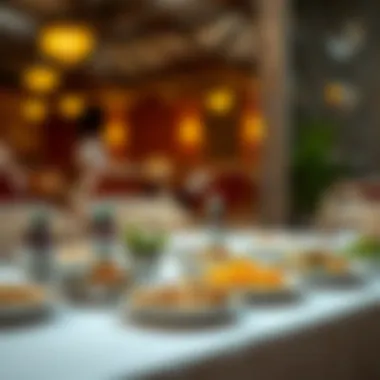

Transport Options
Getting to Mandi restaurants in Dubai offers several avenues. The most popular among them are:
- Public Transportation: The Dubai Metro is a reliable choice, providing a fast and economical method of moving around the city. Major stops, like the Deira City Centre or Burj Khalifa stations, can usher food lovers close to several acclaimed Mandi spots. Buses further complement this network with myriad routes.
- Taxis and Ride-Sharing: For those who prefer a door-to-door service, taxis are plentiful. Ride-sharing apps, like Careem and Uber, are also widely used. Both options allow for a more personalized route, taking diners right to the restaurant of choice, avoiding any hassle with directions.
- Walking and Cycling: Depending on the location, some restaurants may be easily walkable or even reachable by bicycle. This not only helps in soaking in the local atmosphere but also promotes a healthier lifestyle.
Proximity to Popular Areas
Accessibility becomes even more vital when considering the proximity of Mandi establishments to popular attractions. Here’s why it matters:
- Tourist Footfall: Restaurants situated near landmarks such as the Dubai Mall, the Burj Khalifa, or even old Dubai’s rich souks tend to draw a crowd. This proximity allows tourists to indulge in authentic Mandi after sightseeing.
- Business Districts: For professionals, eateries close to business hubs like Dubai Media City or the Dubai World Trade Centre offer convenient dining options during work hours or after meetings. A hearty Mandi meal can serve not just as a culinary delight but also as a networking opportunity while breaking bread with colleagues or clients.
- Community Vibes: Mandi restaurants near residential areas often become community hotspots. They act as gathering locations where friends and families reconnect, offering an inviting atmosphere that enhances the overall dining experience.
Mandi and Health Considerations
When it comes to indulging in Mandi, there’s more than just flavors on the plate; health considerations play a crucial role in how this cuisine fits into our dietary landscape. Mandi, with its rich cultural history and diverse preparation techniques, can also be tailored to suit various health needs. Understanding the nutritional profile and addressing dietary restrictions not only enhances the dining experience but also assures that this delicious dish can be enjoyed responsibly.
Nutritional Analysis
Mandi is essentially a rice dish prepared with meat, often chicken or lamb, that is cooked with a medley of spices. The combination generally offers a balance of macronutrients:
- Carbohydrates: The primary constituent in Mandi is rice, providing a substantial source of energy.
- Protein: The meat component delivers essential protein, necessary for muscle repair and overall health.
- Fats: Depending on the cut of meat and cooking method, the fat content can vary. Opting for leaner cuts can reduce saturated fats.
In terms of vitamins and minerals, Mandi often includes spices like saffron, turmeric, and cumin, each packing a punch.
- Turmeric may help with inflammation.
- Cumin is known for aiding digestion.
A typical serving of Mandi can range from 700 to 900 calories, depending on portion size and ingredients. While this is a hefty meal, it’s also packed with nutrients. To make it healthier, consider the following:
- Choose lean meats: Opting for chicken breast instead of fatty cuts of lamb.
- Control portion sizes: Enjoying a smaller serving can keep caloric intake manageable.
- Incorporate veggies: Adding side salads or grilled vegetables can amplify nutritional value, bringing in more fiber and vitamins.
"A well-planned Mandi feast can be wholesome without sacrificing flavor, making it suitable for varied dietary preferences."
Dietary Restrictions
As Mandi finds its way into dining tables across Dubai, cultural inclusivity means accommodating diverse dietary restrictions. Here’s a breakdown of considerations that might arise:
- Gluten Sensitivity: Mandi is naturally gluten-free as long as it’s made without additions that contain gluten. For those sensitive, it’s always wise to check if the chef uses broth or prepared sauces which may have gluten.
- Lactose Intolerance: While Mandi doesn’t traditionally include dairy, some recipes might use yogurt for marination. It’s best to clarify this beforehand.
- Vegetarian/Vegan Options: Though Mandi is predominantly meat-based, many restaurants now offer plant-based alternatives. Substituting meat with vegetables or plant protein can cater to vegetarian or vegan diners without compromising taste.
- Ethical Eating: Some might choose to avoid meat for ethical reasons. Many establishments are experimenting with vegan Mandi, using tofu or jackfruit as substitutes and embracing spices that mimic traditional flavors.
In summary, having Mandi does not necessarily mean abandoning dietary principles. With thoughtful variations and an understanding of ingredients, Mandi can remain a cherished culinary delight for everyone.
Ending
As we draw the curtains on our exploration of Mandi cuisine in Dubai, it becomes evident that this traditional dish goes beyond just flavors—it encapsulates a rich cultural narrative that binds communities together. The spotlight on Mandi is warranted, not just for its delightful taste but for its historical roots and how it has evolved in a cosmopolitan city like Dubai. Every meal tells a story, connecting diners with the traditions of the Arabian Peninsula.
Final Thoughts on Mandi in Dubai
Mandi's growing presence in Dubai is a testament to the city’s dynamic gastronomy landscape. With its roots traced back centuries, Mandi represents a fusion of both flavor and culture. Many may think of it simply as rice and meat, but delve deeper, and you'll discover an intricate layering of spices and cooking techniques. Each restaurant featured in this article has taken the essence of Mandi and given it a unique twist, catering to the diverse tastes of Dubai's residents and visitors.
- Cultural gem: Enjoying Mandi is not just about eating; it’s a social event often shared with family or friends.
- Regional varieties: From South Asian influences to traditional Bedouin recipes, the variations are abundant, making each dining experience a bit different.
- Popularity growth: The rise of Mandi in Dubai’s culinary scene is not just a trend but a sign of its significance in the cultural tapestry of the city. Mandi has seamlessly integrated into Dubai’s multicultural environment, proving that food can indeed bridge divides.
Encouragement for Culinary Exploration
Embrace the journey of discovery when it comes to Mandi. It encourages a broader exploration of Middle Eastern cuisine, rife with diverse flavors and traditions. If you find yourself in Dubai, allow your palate to wander.
- Try new places: Don't limit yourself to well-known spots. Hidden gems often offer the most authentic experiences.
- Ask the staff: Engaging with restaurant staff about the curries or rice dishes popular among locals can enhance your understanding and appreciation of Mandi.
- Experiment with flavors: Whether you are a meat lover or prefer vegetarian dishes, Mandi can cater to every dietary preference. Pair it with various sauces to heighten your experience.
In summary, Mandi's presence in Dubai not only satisfies hunger; it offers an invitation to partake in a rich culinary journey that tells a story of history, culture, and shared human experience. So, take a leap into the world of Mandi and nourish your body and soul.
"Through exploring Mandi, you traverse the history and culture of the region, bite by precious bite."
To learn more about the cultural significance of Mandi, you can visit Wikipedia or explore community discussions on Reddit.
Ultimately, Mandi is not just a dish; it is an experience waiting to be savored.







